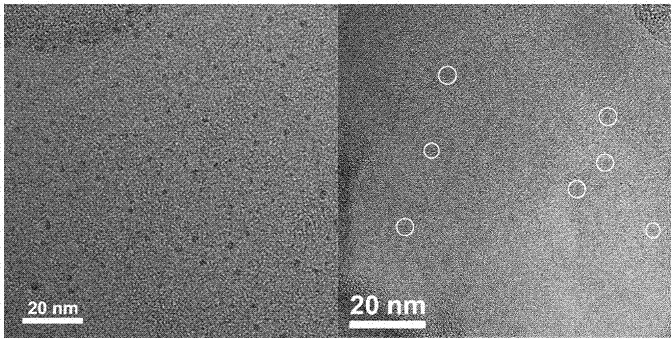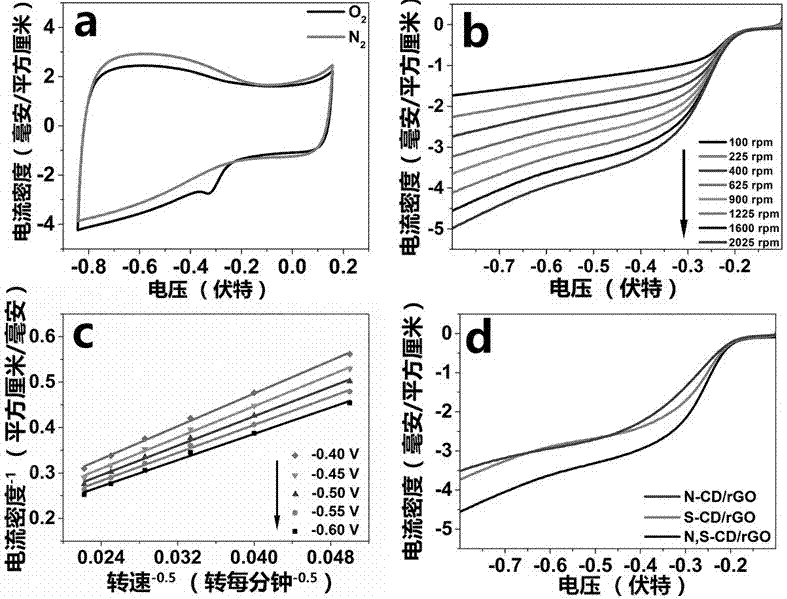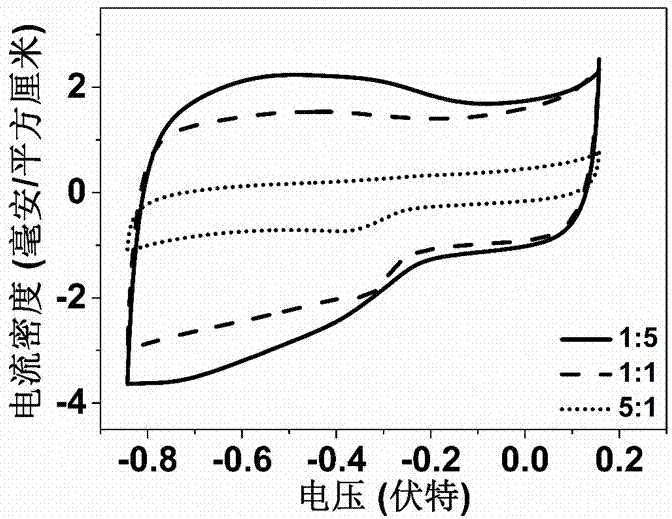Doped carbon dot and graphene compound as well as preparation method and application thereof
A doped graphene technology, applied in the field of nanomaterials, can solve the problems of high price of platinum catalysts, limited large-scale application, increased cost of fuel cell solutions, etc., and achieves a simple and easy preparation method, low cost, The effect of stabilizing chemical and physical properties
- Summary
- Abstract
- Description
- Claims
- Application Information
AI Technical Summary
Problems solved by technology
Method used
Image
Examples
Embodiment 1
[0034] (1) Preparation of nitrogen and sulfur double-doped carbon dots using lipoic acid and ethylenediamine as raw materials
[0035] Dissolve 0.1 gram of lipoic acid, 0.06 gram of ethylenediamine and 0.02 gram of sodium hydroxide in 10 milliliters of deionized water, disperse evenly, transfer to a 50 milliliter polytetrafluoroethylene-lined reactor, and react at 250 ° C for 24 hours Afterwards, the reaction solution was taken out and filtered to remove impurities and dialyzed in deionized water for 48 hours with a 3500 Da molecular weight cut-off dialysis bag, and then the resulting solution was freeze-dried to obtain nitrogen and sulfur double-doped carbon dot powder solids.
[0036] (2) Preparation of nitrogen and sulfur double-doped carbon dots and graphene composites
[0037] 20 mg of graphene oxide was dispersed in 10 mL of deionized water and ultrasonicated for 30 minutes to form a uniform dispersion, then 20 mg of nitrogen and sulfur double-doped carbon dots were adde...
Embodiment 2
[0039] (1) Preparation of phosphorus and sulfur double-doped carbon dots using lipoic acid and phytic acid as raw materials
[0040] Dissolve 0.1 g of lipoic acid and 0.06 g of phytic acid in 10 ml of deionized water, disperse evenly, transfer to a 50 ml polytetrafluoroethylene-lined reactor, react at 250 ° C for 24 hours, then take out the reaction solution and filter Impurities were removed and a dialysis bag with a molecular weight cut-off of 3500 Da was dialyzed in deionized water for 48 hours, and then the resulting solution was freeze-dried to obtain a solid phosphorus and sulfur double-doped carbon dot powder.
[0041] (2) Preparation of phosphorus and sulfur double-doped carbon dots and graphene composites
[0042] This step is the same as step (2) of Example 1, and the obtained product is the carbon dot / graphene composite material doped with phosphorus and sulfur in the present invention, named P,S-CD / rGO (1:1).
Embodiment 3
[0044] (1) Nitrogen and phosphorus double-doped carbon dots were prepared using phytic acid and ethylenediamine as raw materials
[0045] Dissolve 0.06 g of phytic acid and 0.02 g of ethylenediamine in 10 ml of deionized water, disperse evenly, transfer to a 50 ml polytetrafluoroethylene-lined reactor, react at 250 ° C for 24 hours, and then take out the reaction solution Impurities were removed by filtration and dialyzed in deionized water for 48 hours with a 3500 Da molecular weight cut-off bag, and then the resulting solution was freeze-dried to obtain a nitrogen-phosphorus double-doped carbon dot powder solid.
[0046] (2) Preparation of nitrogen and phosphorus double-doped carbon dots and graphene composites
[0047] This step is the same as step (2) of Example 1, and the obtained product is the phosphorous and sulfur double doped carbon dot / graphene composite material of the present invention, named N,P-CD / rGO (1:1).
PUM
| Property | Measurement | Unit |
|---|---|---|
| Diameter | aaaaa | aaaaa |
| Granularity | aaaaa | aaaaa |
Abstract
Description
Claims
Application Information
 Login to View More
Login to View More - R&D
- Intellectual Property
- Life Sciences
- Materials
- Tech Scout
- Unparalleled Data Quality
- Higher Quality Content
- 60% Fewer Hallucinations
Browse by: Latest US Patents, China's latest patents, Technical Efficacy Thesaurus, Application Domain, Technology Topic, Popular Technical Reports.
© 2025 PatSnap. All rights reserved.Legal|Privacy policy|Modern Slavery Act Transparency Statement|Sitemap|About US| Contact US: help@patsnap.com



